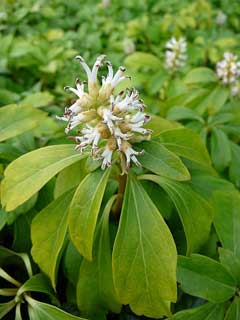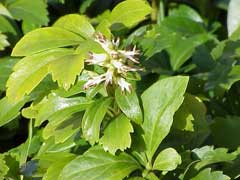 |
|
http://commons.wikimedia.org/wiki/User:4028mdk09 |
 |
| biolib.de |
Translate this page:
Summary
Bloom Color: White. Main Bloom Time: Early spring, Mid spring. Form: Spreading or horizontal, Variable spread.
Physical Characteristics

 Pachysandra terminalis is an evergreen Shrub growing to 0.2 m (0ft 8in) by 0.5 m (1ft 8in) at a medium rate.
Pachysandra terminalis is an evergreen Shrub growing to 0.2 m (0ft 8in) by 0.5 m (1ft 8in) at a medium rate.
See above for USDA hardiness. It is hardy to UK zone 5 and is not frost tender. It is in leaf all year, in flower from April to May, and the seeds ripen from September to October. The species is monoecious (individual flowers are either male or female, but both sexes can be found on the same plant).
Suitable for: light (sandy), medium (loamy) and heavy (clay) soils and prefers well-drained soil. Suitable pH: mildly acid, neutral and basic (mildly alkaline) soils and can grow in very acid and very alkaline soils.
It can grow in full shade (deep woodland) or semi-shade (light woodland). It prefers dry or moist soil and can tolerate drought.
UK Hardiness Map
US Hardiness Map
Synonyms
Plant Habitats
Woodland Garden Dappled Shade; Shady Edge; not Deep Shade; Ground Cover;
Edible Uses
Edible Parts: Fruit
Edible Uses:
Fruit - raw or cooked. Sweet and juicy[105]. The ovoid fruits are 5 - 6mm long[266]. The fruit is not usually produced in cultivation[200] - this could be because both male and female plants are required and most people only grow one plant.
References More on Edible Uses
Medicinal Uses
Plants For A Future can not take any responsibility for any adverse effects from the use of plants. Always seek advice from a professional before using a plant medicinally.
None known
References More on Medicinal Uses
The Bookshop: Edible Plant Books
Our Latest books on Perennial Plants For Food Forests and Permaculture Gardens in paperback or digital formats.

Edible Tropical Plants
Food Forest Plants for Hotter Conditions: 250+ Plants For Tropical Food Forests & Permaculture Gardens.
More

Edible Temperate Plants
Plants for Your Food Forest: 500 Plants for Temperate Food Forests & Permaculture Gardens.
More

More Books
PFAF have eight books available in paperback and digital formats. Browse the shop for more information.
Shop Now
Other Uses
A very useful ground cover plant for a shady position, spreading by means of underground runners[182, 190]. A vigorous grower, but it is not too invasive[200].It grows well in the shade of shrubs[K].
Special Uses
Ground cover Scented Plants
References More on Other Uses
Cultivation details
Landscape Uses:Border, Container, Erosion control, Ground cover, Rock garden, Woodland garden. A very tolerant plant, it thrives in any moist well-drained soil[11, 200]. Easily grown in a loose leafy soil succeeding in dry shade[187] and tolerating drought once it is established[190]. Grows well under trees[11]. Dislikes dry soils, full sun and strong winds[200]. Prefers a lime-free soil[182] according to one report whilst another says that it succeeds in acid and alkaline soils[200]. Hardy to about -25°c[187]. Plants are monoecious and rarely if ever produce fruit in cultivation[187, 200]. The flowers have a pleasant sweet fragrance[245]. At least one named form has been selected for its ornamental value[187]. Special Features:
Attractive foliage, Not North American native, Naturalizing, Fragrant flowers, Inconspicuous flowers or blooms.
References Carbon Farming Information and Carbon Sequestration Information
Temperature Converter
Type a value in the Celsius field to convert the value to Fahrenheit:
Fahrenheit:
The PFAF Bookshop
Plants For A Future have a number of books available in paperback and digital form. Book titles include Edible Plants, Edible Perennials, Edible Trees,Edible Shrubs, Woodland Gardening, and Temperate Food Forest Plants. Our new book is Food Forest Plants For Hotter Conditions (Tropical and Sub-Tropical).
Shop Now
Plant Propagation
Seed - we have no information on this species but suggest sowing the seed in a cold frame as soon as it is ripe if this is possible, otherwise sow it in late winter. Prick out the seedlings into individual pots when they are large enough to handle and grow on in a shady part of the greenhouse or cold frame. Plant out in early summer of the following year. Cuttings of half-ripe wood, 4 - 7cm long taken at a node, June - August in a shady position in a frame[78]. Division in spring[200]. Very easy, larger divisions can be planted out direct into their permanent positions. We have found that it is better to pot up the smaller divisions and grow them on in light shade in a cold frame until they are well established before planting them out in late spring or early summer[K].
Other Names
If available other names are mentioned here
Native Range
TEMPERATE ASIA: China (Gansu Sheng, Hubei Sheng, Shaanxi Sheng, Sichuan Sheng, Zhejiang Sheng), Japan (Hokkaidô, Honshu, Kyushu, Shikoku)
Weed Potential
Right plant wrong place. We are currently updating this section.
Please note that a plant may be invasive in one area but may not in your area so it's worth checking.
Conservation Status
IUCN Red List of Threatened Plants Status :

Growth: S = slow M = medium F = fast. Soil: L = light (sandy) M = medium H = heavy (clay). pH: A = acid N = neutral B = basic (alkaline). Shade: F = full shade S = semi-shade N = no shade. Moisture: D = dry M = Moist We = wet Wa = water.
Now available:
Food Forest Plants for Mediterranean Conditions
350+ Perennial Plants For Mediterranean and Drier Food Forests and Permaculture Gardens.
[Paperback and eBook]
This is the third in Plants For A Future's series of plant guides for food forests tailored to
specific climate zones. Following volumes on temperate and tropical ecosystems, this book focuses
on species suited to Mediterranean conditions—regions with hot, dry summers and cool, wet winters,
often facing the added challenge of climate change.
Read More
Expert comment
Author
Siebold.&Zucc.
Botanical References
1158200
Links / References
For a list of references used on this page please go here
Readers comment
© 2010, Plants For A Future. Plants For A Future is a charitable company limited by guarantee, registered in England and Wales. Charity No. 1057719, Company No. 3204567.